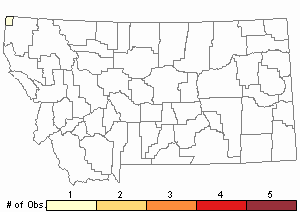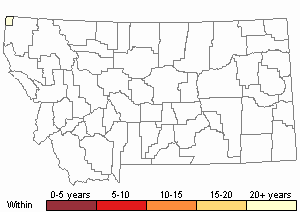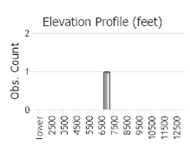View in other NatureServe Network Field Guides
NatureServe
Montana
Utah
Wyoming
Idaho
Wisconsin
British Columbia
South Carolina
Yukon
California
New York
Pygmy Racomitrium Moss - Niphotrichum pygmaeum
Other Names:
Racomitrium pygmaeum
State Rank Reason (see State Rank above)
Distribution data in BIOTICS had Distribution Confidence as "Reported but unconfirmed" with no explanatory notes (Spribille report). FNA 2014 does not show this in Montana.
General Description
Plants: Small and slight, olive green to yellow with green tones. Stems typically 5-25 mm in length, curving upward, nearly pinnately branched to scarcely branched; rhizoids characteristically throughout (FNA 2007).
Leaves: Similar dry as when wet, overlapping somewhat, spreading a little to ca 45 degrees or curved back and downward slightly when wet, 1.5-1.8 mm in length, 0.5-0.6 mm in width, lance-shaped with ovate tendencies, with small, plane auricles; margins curved back and down throughout or only faintly so along part of each margin; usually with a hair-point, seldom wanting, the hair-point somewhat long on the topmost leaves, subulate, with a few fine teeth, lacking papillae or with a few papillae below, not extending back along the margins; costa extending to the apex, not lying in a groove, very flat on the dorsal surface (FNA 2007).
Leaf Cells: Margins unistratose; costa of 2 cell layers throughout or sometimes 3 near the base; middle and upper laminal cells nearly square or slightly lengthened, sinuose, appearing yellowish and opaque from the thick covering of large papillae on both surfaces; basal laminal cells long and quadrangular, with walls pitted, knobby, and somewhat thick, lacking papillae in the several rows at the leaf attachment; alar cells nearly square or lengthened slightly with fine walls, transparent or translucent in 3-6 rows; supra-alar cells square or nearly so, with fine, straight walls, creating borders at the margins of up to 15 cells (FNA 2007).
Diagnostic Characteristics
Distinguished by its hair-point with no or few papillae at its base, the costa which is percurrent and not lying in a groove, the diminutive auricles, and the yellowish upper laminal cells thickly covered with prominent papillae (FNA 2007).
Range Comments
Known only in BC and WA. Rare; few collections have been made (FNA 2007). Also known in Montana from the Whitefish Range (Elliott 2016).
Observations in Montana Natural Heritage Program Database
Number of Observations: 1
(Click on the following maps and charts to see full sized version)
Map Help and Descriptions
Relative Density

Recency



 (Observations spanning multiple months or years are excluded from time charts)
(Observations spanning multiple months or years are excluded from time charts)
Habitat
Acidophilic; on dry, exposed soil of heaths above timberline. Elevation: 6230-8200 feet (FNA 2007).
Reproductive Characteristics
Fruit unknown (FNA 2007).
Stewardship Responsibility
References
- Literature Cited AboveLegend:
 View Online Publication
View Online Publication Elliott, J.C. and A.K. Pipp. 2018. A Checklist of Montana Mosses (1880-2018). Updated 3 January, 2020. Montana Natural Heritage Program, Helena, Montana. 73 pp.
Elliott, J.C. and A.K. Pipp. 2018. A Checklist of Montana Mosses (1880-2018). Updated 3 January, 2020. Montana Natural Heritage Program, Helena, Montana. 73 pp.
- Additional ReferencesLegend:
 View Online Publication
View Online Publication
Do you know of a citation we're missing? Elliot, J. C. 1993. Second checklist of Montana mosses. Unpublished report. U.S. Forest Service, Region 1. Missoula, MT. 45 pp.
Elliot, J. C. 1993. Second checklist of Montana mosses. Unpublished report. U.S. Forest Service, Region 1. Missoula, MT. 45 pp. Lawton, E. 1971. Keys for the Identification of the Mosses on the Pacific Northwest. Reprinted from 'Moss Flora of the Pacific Northwest'. Published as Supplement No. 2 of the Journal of the Hattori Botanical Laboratory. Nichinan, Miyazaki, Japan. 66 pp.
Lawton, E. 1971. Keys for the Identification of the Mosses on the Pacific Northwest. Reprinted from 'Moss Flora of the Pacific Northwest'. Published as Supplement No. 2 of the Journal of the Hattori Botanical Laboratory. Nichinan, Miyazaki, Japan. 66 pp. Lawton, E. 1971. Moss Flora of the Pacific Northwest. Hattori Botanical Laboratory. Japan: Yamabuki-cho, Shinjuku-ku, Tokyo. 362 pages plus appendices.
Lawton, E. 1971. Moss Flora of the Pacific Northwest. Hattori Botanical Laboratory. Japan: Yamabuki-cho, Shinjuku-ku, Tokyo. 362 pages plus appendices.
- Web Search Engines for Articles on "Pygmy Racomitrium Moss"





